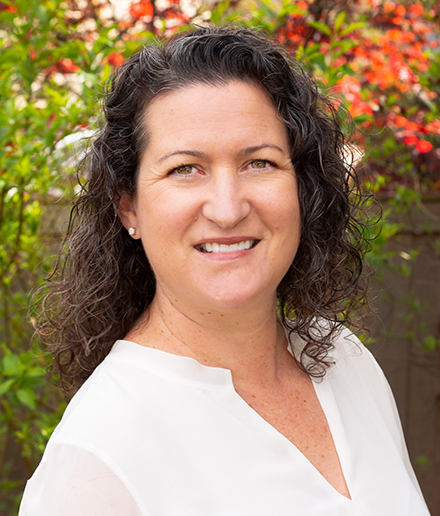Chair and Professor
Health Behavior and Health Promotion

I consider myself a public health 'lifer,' having focused my education and career on the research and practice of disease prevention. Growing up in a time and place where tobacco use was the norm, I wanted to learn how to prevent nicotine addiction and promote cessation. While we have made amazing strides in the adoption of tobacco control policies since those early days of smoking in airplanes, movie theaters and restaurants, we still have substantial work to do in order to reduce the burden of death and disease from tobacco.
Contact
1841 Neil Avenue
358 Cunz Hall
Columbus, OH 43210
Email: klein.232@osu.edu
Phone: 614-292-5424
View CV
I joined the College of Public Health faculty in 2008, and I have been actively involved in public health since 1995. My academic background is in behavioral epidemiology, and my research and practice experiences in public health focus around the primary prevention of chronic disease. I have worked in research and in practice in a range of settings, and make efforts to bring my real world experiences into the classroom to help students make the academic-practice connection. Teaching the next generation of public health professionals is a key part of professional duties.
The theme of my research agenda is the use of a multi-level, social-ecological approach in the prevention or reduction of tobacco use, with a particular interest in understanding the role of policy, systems and environmental change (PSEC) strategies and their influence on population health behavior, particularly tobacco use. My work has been influenced to a great extent by the social-ecological model, and its five levels of influence on human behavior: individual, interpersonal, organizational, community, and policy. Given the focus on primary prevention of tobacco use, the population groups of greatest interest in my work are the age groups of youth and young adults. Most recently, I have expanded this focus to include other vulnerable populations at high risk for tobacco use, including low-income individuals and underserved rural residents.
Tobacco control; primary prevention of chronic disease; social determinants of health, Policy, systems and environmental change; primary prevention; public health evaluation
- PhD, Behavioral Epidemiology, University of Minnesota, 2007
- MPH, Epidemiology and Biostatistics, University of California, Berkeley, 2002
- BS, Community Health Education, Western Michigan University, 1995
- Klein, E.G.; Kierstead, E.; Czaplicki, L.; Berman, M.; Emery, S.; Schillo, B. (2021). Testing potential disclosures for sponsorship on social media: A randomized experiment. Am J Health Behav. 45(3): 1-8.
- Klein, E.G.; Koopman Gonzalez, S.; Pike Moore, S.; Bohnert, E.J.; Quisenberry, A.J.; Trapl, E. (2020). Pulling your mask down to smoke: Qualitative themes from young adults on nicotine use during a pandemic. Sub Use Misuse. Doi: 10.1080/10826084.2020.1869264
- Klein, E.G.; Alawan, M.A.; Pennell, M.; Angeles, D.; Brinkman, M.; Keller-Hamilton, B.; Roberts, M.; Nini, P.; Ferketich, A.K. (2021). Waterpipe warning placement and risk perceptions: An eye tracking study. Am J Health Behav. 45(1): 186-194. Doi: 10.5993/AJHB.45.1.15
- Klein, E.G.; Macisco, J.; Lazard, A.; Busho, A.; Oslock, A.; Worly, B. (2020). Framing pregnancy-related tobacco cessation messages for women of reproductive age. Addict Behav Rep, doi: 10.1016/j.abrep.2020100290
- Klein, E.G.; Roberts, K.; Manganello, J.; McAdams, R.; McKenzie, L. (2020). When images and messages don’t match: Attention to text versus imagery to effectively convey safety information on social media. J Health Commun. Doi: 10.1080/10810730.2020.1853282
- +Busho, A.; Macisco, J.; Oslock, A.; Worly, B.; Klein, E.G. (2020). Framing pregnancy-related tobacco cessation messages for women of reproductive age. Addict Behav Rep, 12: doi: 10.1016/j.abrep.2020.100290
- +Moumen, M.+, Brinkman, M., Keller-Hamilton, B., Tererra, A., Roberts, M., Klein, E.G. et al. (2020). Waterpipe tobacco warnings need to inform users of harm: Evidence from studies with young adults. Tob Regul Sci, 6(4): 279-288.
- Klein, E.G.; Kierstead, E.; Czaplicki, L.; Berman, M.; Emery, S.; Schillo, B. (2020). Visual attention to the use of #ad versus #sponsored on e-cigarette influencer posts on social media: a randomized experiment. J Health Commun; 10.1080/10810730.2020.1849464.
- Shoots-Reinhard B, Erford B, Romer D, Evans A, Shoben A, Klein EG, Peters E. Numeracy and Memory for Risk Probabilities and Risk Outcomes Depicted on Cigarette Warning Labels. Health Psychol. 2019 Dec 12;16:E161. doi: 10.5888/pcd16.190232. PubMed PMID: 31831106; PubMed Central PMCID: PMC6936666.
- +Reisinger SA, Kamel S, Seiber E, Klein EG, Paskett ED, Wewers ME. Cost-Effectiveness of Community-Based Tobacco Dependence Treatment Interventions: Initial Findings of a Systematic Review. Prev Chronic Dis. 2019 Dec 12;16:E161. doi: 10.5888/pcd16.190232. PubMed PMID: 31831106; PubMed Central PMCID: PMC6936666.
- Wagoner KG, Berman M, Rose SW, Song E, Cornacchione Ross J, Klein EG, Kelley DE, King JL, Wolfson M, Sutfin EL. Health claims made in vape shops: an observational study and content analysis. Tob Control. 2019 Dec;28(e2):e119-e125. doi: 10.1136/tobaccocontrol-2018-054537. Epub 2019 May 23. PubMed PMID: 31123104.
- Klein EG, Quisenberry AJ, Shoben AB, Romer D, Peters E. The Influence of Health Numeracy and Health Warning Label Type on Smoking Myths and Quit-Related Reactions. Nicotine Tob Res. 2019 Jun 21;21(7):974-978. doi: 10.1093/ntr/nty207. PubMed PMID: 30285145; PubMed Central PMCID: PMC6588388.
- Peters E, Shoots-Reinhard B, Evans AT, Shoben A, Klein EG, Tompkins MK, Romer D, Tusler M. Pictorial Warning Labels and Memory for Cigarette Health-risk Information Over Time. Ann Behav Med. 2019 Mar 20;53(4):358-371. doi: 10.1093/abm/kay050. PubMed PMID: 29947729; PubMed Central PMCID: PMC6289901.
- Kaufman A, Klein EG, Koblitz A, Price S. A Vision for Eye-tracking Research in Tobacco Regulatory Science. Tob Regul Sci. 2018 Nov;4(6):3-7. doi: 10.18001/TRS.4.6.1. PubMed PMID: 31363488; PubMed Central PMCID: PMC6667163.
- Quisenberry AJ, Scott AE, Shoben AB, Ferketich AK, Cooper SE, Berman M, Peters E, Ellen Wewers M, Klein EG. Health Literacy and Attention to Cigarette Health Warning Labels among Rural Smokers. Tob Regul Sci. 2018 Nov;4(6):38-46. doi: 10.18001/TRS.4.6.4. PubMed PMID: 31363489; PubMed Central PMCID: PMC6667177.
- Klein EG, Quisenberry AJ, Shoben AB, Cooper S, Ferketich AK, Berman M, Peters E, Wewers ME. Health Warning Labels for Smokeless Tobacco: The Impact of Graphic Images on Attention, Recall, and Craving. Nicotine Tob Res. 2017 Oct 1;19(10):1172-1177. doi: 10.1093/ntr/ntx021. PubMed PMID: 28339596.
- Meernik C, Jarman K, Wright ST, Klein EG, Goldstein AO, Ranney L. Eye Tracking Outcomes in Tobacco Control Regulation and Communication: A Systematic Review. Tob Regul Sci. 2016 Oct;2(4):377-403. PubMed PMID: 27668270; PubMed Central PMCID: PMC5033068.
- Klein EG, Berman M, Hemmerich N, Carlson C, Htut S, Slater M. Online E-cigarette Marketing Claims: A Systematic Content and Legal Analysis. Tob Regul Sci. 2016 Jul;2(3):252-262. Epub 2016 Jul 1. PubMed PMID: 27446984; PubMed Central PMCID: PMC4950517.
- Klein EG, Shoben AB, Krygowski S, Ferketich A, Berman M, Peters E, Rao U, Wewers ME. Does Size Impact Attention and Recall of Graphic Health Warnings? Tob Regul Sci. 2015 Jul;1(2):175-185. Epub 2015 Jul 1. PubMed PMID: 26550583; PubMed Central PMCID: PMC4631437.
- Jin Y, Lu B, Klein EG, Berman M, Foraker RE, Ferketich AK. Tobacco-Free Pharmacy Laws and Trends in Tobacco Retailer Density in California and Massachusetts. Am J Public Health. 2016 Apr;106(4):679-85. doi: 10.2105/AJPH.2015.303040. Epub 2016 Feb 18. PubMed PMID: 26890173.
- Klein EG, Hood NE. The smoking ban next door: do hospitality businesses in border areas have reduced sales after a statewide smoke-free policy? Health Policy. 2015 Jan;119(1):44-9. doi: 10.1016/j.healthpol.2014.09.011. Epub 2014 Sep 30. PubMed PMID: 25303831.
- Klein EG, Kennedy RD, Berman M. Tobacco control policies in outdoor areas of high volume American transit systems. J Community Health. 2014 Aug;39(4):660-7. doi: 10.1007/s10900-014-9873-3. Review. PubMed PMID: 24719261.
Access a full citation list here.






